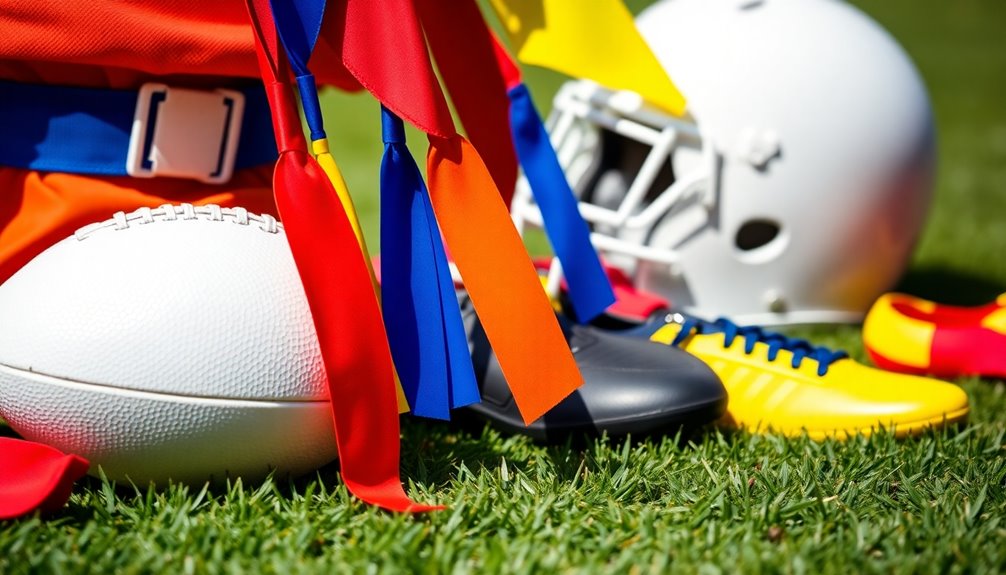
Flag Football Gear: A Complete Guide for Beginners
January 27, 2025To get started in flag football, you'll need some essential gear to stay safe and play well. First, grab a nylon belt with flags and a mouthguard; both are mandatory. Wear pocketless shorts for safety and visibility of your flags. Invest in good football cleats for traction, but skip the metal spikes to avoid injuries. Consider integrated apparel like moisture-wicking shirts and arm sleeves for comfort and protection. Optional accessories like receiver gloves can enhance grip. Familiarizing yourself with gear requirements helps you play effectively. There's even more to explore about getting game-ready and performing your best!
Overview of Flag Football
Flag football offers a thrilling alternative to traditional football, particularly for those who want to enjoy the game without the physical contact. This non-contact sport is perfect for players of all ages and skill levels, allowing everyone to experience the excitement and speed of football.
Typically played with teams of 5-on-5, the game unfolds on a field measuring 25-30 yards wide and 70 yards long, featuring two 10-yard end zones. Each game is fast-paced, lasting 40 minutes, split into two 20-minute halves. The offense begins on the 5-yard line and has four downs to advance the ball. Scoring is straightforward: touchdowns are worth six points, with extra points varying from 1 to 3 depending on the play executed after a touchdown. The competitive nature of the sport can foster team dynamics that mirror those seen in traditional football.
Key gameplay rules revolve around pulling flags from ball carriers instead of tackling, which enhances safety and keeps the game moving. Additionally, teams must ensure they do not exceed the specific number of players allowed on the field. With no run zones enforced 5 yards before midfield and the end zones, players must strategize their moves carefully. Additionally, understanding key regulations can significantly enhance the enjoyment of the game.
Essential Gear for Players
When you're gearing up for flag football, having the right equipment is essential for both performance and safety.
You'll need a nylon belt with flags, pocketless shorts, and a mouthguard to comply with safety regulations. Proper endurance and conditioning routines can help improve your performance on the field. Additionally, consider football cleats for traction and receiver gloves for better grip on the ball. Properly fitting football cleats is crucial as it enhances agility, control, and overall playing experience. Make sure to consult brand-specific sizing guides to find the best fit for your cleats.
Required Protective Equipment
In flag football, keeping yourself safe on the field starts with the right protective equipment. The only mandatory item you need is a mouthguard. It's vital for protecting your teeth and gums during gameplay, so make certain to pick one that fits well.
It's also wise to stash backup mouthguards in your bag, just in case you lose or damage the one you're using.
Another important piece of equipment is pocketless shorts. These are required to help prevent injuries and guarantee that your flags are easily visible during play.
Avoid shorts with pockets, as they can lead to safety hazards on the field.
While not mandatory, wearing football cleats can give you ideal traction, helping you make quick cuts and sprint effectively.
Just remember that metal spikes are prohibited, as they can increase injury risks.
Recommended Apparel and Accessories
To enhance your performance on the field, choosing the right apparel and accessories is just as important as protective equipment. Start with a nylon belt to securely hold your football flags, which are essential for gameplay. These flags allow for quick and easy removal, keeping the game flowing smoothly.
Opt for flag football-specific shorts, as they're pocketless, ensuring that nothing interferes with your flags. This design not only enhances safety but also improves visibility during plays.
For better grip on the football, consider investing in receiver gloves. While they're optional, many players swear by them for improved ball control.
Don't overlook the benefits of compression apparel. It provides support and enhances mobility, allowing you to perform at your best during both games and practices.
Pair your compression gear with high-quality football socks, which can help prevent blisters and offer extra comfort throughout the match.
Safety Considerations and Compliance
Safety considerations in flag football are essential for protecting players and ensuring compliance with league standards. One of the most critical pieces of protective gear that players must wear is a mouthguard. This not only safeguards your teeth and gums but also minimizes the risk of injury during gameplay. It's wise to have a backup mouthguard on hand for added safety.
Moreover, pocketless shorts are mandatory. They enhance visibility of your flags and reduce the potential for injuries while you're on the field. NFL FLAG provides essential gear, including official belts and flags, upon registration, ensuring compliance with league standards.
When it comes to footwear, opt for football cleats that offer ideal traction. Be sure to avoid metal spikes, as they're prohibited to lessen the risk of injury.
Additionally, consider integrated apparel and arm sleeves. These can provide extra protection against minor injuries, boosting your overall safety during play.
Protective Equipment
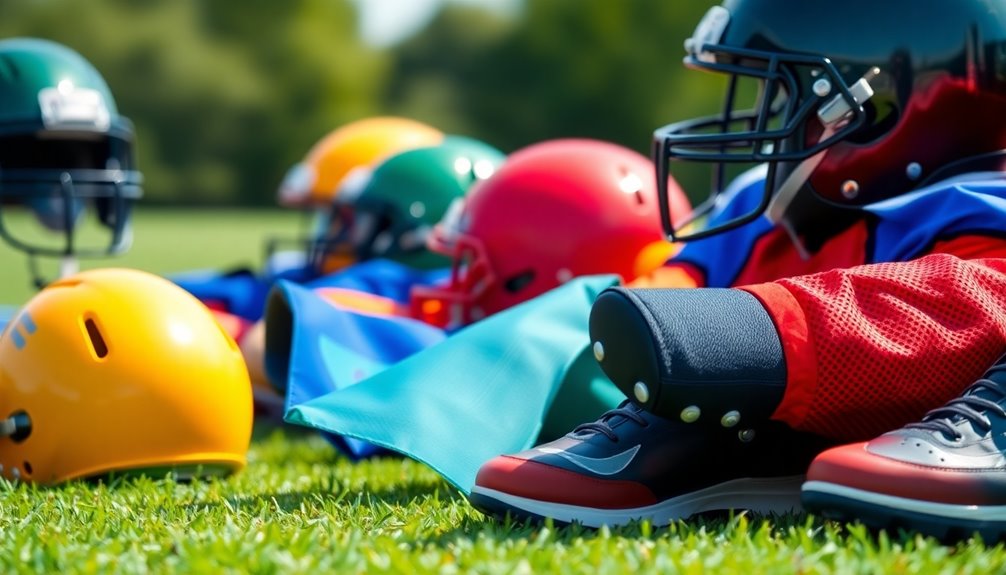
When you hit the field for flag football, wearing a mouthguard is essential to protect your teeth from injury. To enhance your overall performance and safety, consider incorporating dynamic warm-up routines into your pre-game preparation. Integrated apparel, like arm sleeves, can also help guard against minor scrapes and bruises during play. Plus, sticking to minimal contact precautions guarantees everyone's safety while keeping the game fun and competitive. Additionally, incorporating proper stretching techniques before and after games can enhance flexibility and reduce the risk of injuries. Engaging in dynamic stretches prior to the game is crucial for preparing your muscles and preventing injuries.
Importance of Mouthguards
Wearing a mouthguard is essential in flag football, as it protects your teeth and minimizes the risk of oral injuries during the game. While flag football is a non-contact sport, unexpected collisions can still occur, and mouthguards play a significant role in absorbing shocks from impacts.
They're mandatory for maintaining player safety, guaranteeing that you can focus on the game without worrying about potential dental damage.
Mouthguards come in various styles, including stock, boil-and-bite, and custom-fit options. Custom mouthguards provide the best fit and protection, adapting to your mouth's unique shape for maximum comfort.
However, it's always a good idea to have backup mouthguards on hand. Losing or damaging your primary mouthguard can happen, and having a replacement guarantees you're always prepared to hit the field safely.
Emphasizing proper gear, including mouthguards, is critical for player safety. By investing in a quality mouthguard, you're not only protecting your smile but also enhancing your overall experience in flag football.
Don't underestimate the importance of this small piece of equipment; it could make all the difference in your game.
Integrated Apparel Benefits
Integrated apparel, like compression shirts and shorts, can greatly enhance your performance on the field. These garments improve your mobility and comfort during games and practices, allowing you to focus on your skills.
Arm sleeves, for instance, not only provide warmth but also protect against minor injuries, reducing the risk of abrasions and bruises. The use of integrated protective gear is essential for player safety while maintaining the non-contact nature of flag football.
You'll appreciate how these items help keep you safe without compromising your gameplay. Many integrated apparel options feature moisture-wicking technology, which manages sweat during intense gameplay, keeping you dry and comfortable.
Additionally, look for apparel designed with reinforced seams and durable materials. This enhances durability, ensuring your gear withstands the rigors of flag football, so you won't have to worry about wear and tear.
Investing in quality integrated apparel means you can enjoy your time on the field without distractions, knowing you're protected and performing at your best. Embrace the benefits of integrated apparel, and elevate your flag football experience!
Minimal Contact Precautions
While integrated apparel enhances your performance on the field, taking precautions for minimal contact is just as important.
Even though flag football is a non-contact sport, using mouthguards is highly encouraged to protect against oral injuries. It's wise to keep a backup mouthguard handy for added safety.
Consider wearing arm sleeves, which can help minimize scrapes and abrasions during gameplay. Many players opt for these to guarantee they stay injury-free.
Additionally, pocketless shorts are mandatory in many leagues. This rule not only enhances the visibility of your flags but also prevents any injuries that could arise from pocketed items during play.
Starting Out in Flag Football
Getting started in flag football involves a few essential steps to guarantee you're prepared and safe on the field. First, familiarize yourself with the essential gear, like pocketless shorts, mouthguards, and NFL FLAG belts. Wearing the right equipment guarantees compliance and enhances safety during games. Additionally, understanding essential equipment for safety and performance is crucial to ensure you are well-prepared. Engaging in speed, agility, and endurance workouts can also improve your overall athleticism, benefiting your performance on the field.
Next, immerse yourself in understanding the rules of gameplay, especially flag removal and scoring. This knowledge is vital for new players to participate effectively. Engage in practice sessions with your team; this greatly improves your skills and helps you grasp the importance of teamwork and communication. Teamwork is essential for success in soccer, and the same principle applies in flag football.
Consider joining local flag football leagues, where regular participation can boost your confidence and skills while fostering a sense of community among players of all ages.
To keep everything organized, create a checklist for new players that outlines the necessary equipment and preparation steps. This checklist will guide you through your journey, making sure you have everything you need to start strong.
Additional Considerations
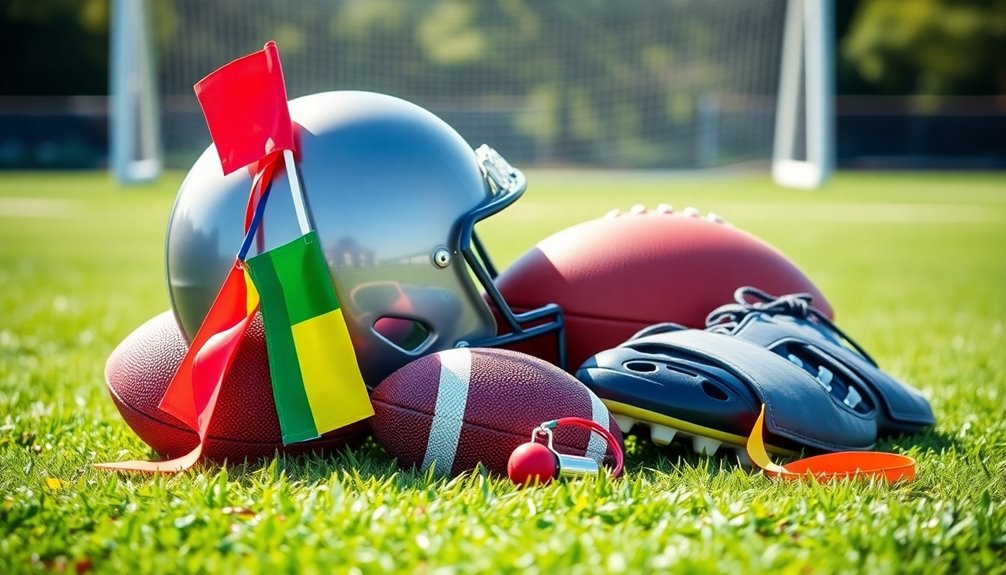
When stepping into the world of flag football, there are additional considerations that can enhance your experience on the field.
First, keep in mind that flag football leagues cater to players of all ages and skill levels, promoting inclusivity and community engagement. This means you'll likely find a league that fits your personal preferences and abilities.
Next, be aware that equipment requirements can vary between leagues. Before you jump in, check the specific regulations of your chosen league to guarantee you have the right gear. Understanding the importance of specific regulations will help you avoid any potential issues during play. Additionally, leagues often emphasize commitment and dedication, which can significantly improve your performance and enjoyment of the game.
Many leagues simplify this process by providing essential gear, like NFL FLAG belts and flags, upon registration, making it easier for new players to get started.
Additionally, flag football emphasizes sportsmanship and fair play, so be prepared to uphold these values. A positive attitude not only enhances your own experience but also contributes to a welcoming environment for everyone involved. By fostering community bonds among players and families, you'll enhance the overall enjoyment of the game.
Finally, remember that flag football serves as a fantastic introduction to traditional football, helping you develop foundational skills and a better understanding of the game.
Embrace these considerations, and you'll be well on your way to enjoying flag football to its fullest!
Required Equipment
To fully participate in flag football, you'll need specific equipment that guarantees both safety and compliance with league rules. First and foremost, you must wear a nylon belt with flags attached on each side. These flags are essential for gameplay, as opponents must pull them to stop the ball-carrier.
In addition to belts and flags, mouthguards are mandatory for all players. They provide vital oral protection during play, and it's a good idea to have a backup on hand, just in case.
You'll also need pocketless shorts; these are required to enhance safety and visibility of the flags. By wearing pocketless shorts, you reduce the risk of injury during gameplay, as they prevent flags from getting caught in pockets.
While not strictly required, football cleats are highly recommended for best traction on the field. Just make sure to avoid metal spikes to minimize injury risks.
Finally, many players choose to wear receiver gloves to improve grip on the football and enhance ball control, though they're not mandatory. With this gear, you'll be well-equipped to hit the field!
Flag Football Flags and Belts
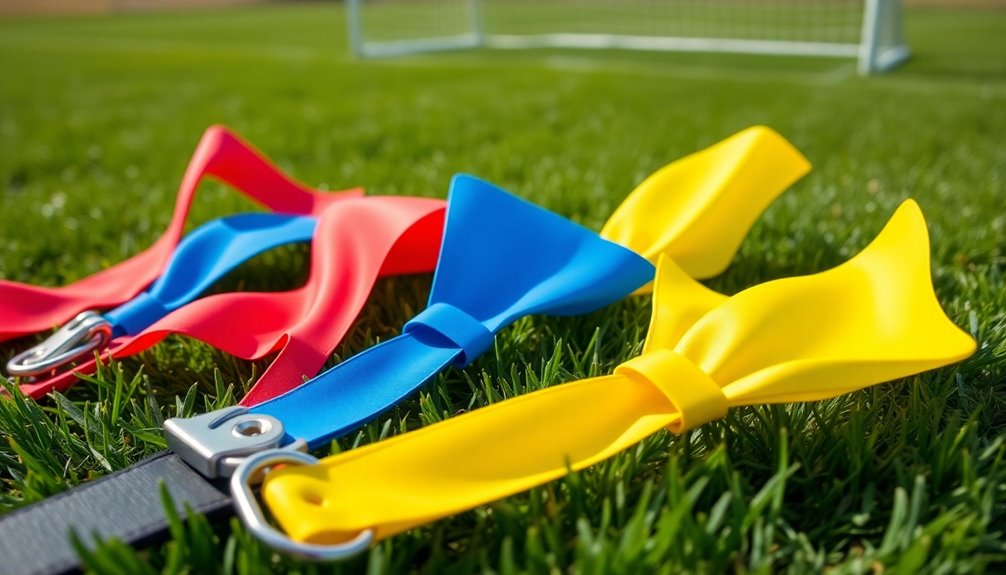
In flag football, the belts and flags you wear play a pivotal role in the game. You'll wear belts with flags attached to each side, which are essential for gameplay. Opponents must pull these flags to stop you, the ball-carrier, so it's vital that your flags are clearly visible during play. If they aren't, you might face penalties for flag guarding, which can disrupt the flow of the game.
Typically, your league or coach will provide official NFL FLAG gear, ensuring everyone has the proper equipment. Each belt should securely hold the flags in place, so any issues with visibility or attachment can lead to gameplay disruptions.
As you prepare for your games, make sure your belt and flags are in good condition. Familiarizing yourself with the rules regarding flag removal is also important. Knowing how to effectively pull flags will enhance your defensive skills and contribute to your team's success.
Safety Gear
Wearing the right safety gear is essential for enjoying flag football while minimizing injury risks. The most vital piece of equipment you need is a mouthguard. This mandatory gear protects your teeth and gums from potential oral injuries during play.
It's smart to keep a backup mouthguard in your bag, ensuring you're always prepared for practice or games.
In terms of clothing, opt for pocketless shorts. These are required for safety reasons, as they help maintain the visibility of your flags, which is critical for fair play and avoiding penalties.
Proper flag visibility also reduces the risk of injuries, allowing everyone to play safely and effectively.
When it comes to footwear, remember that metal cleats are a no-go in flag football. They can increase the risk of foot and ankle injuries on the field.
Instead, choose cleats designed specifically for flag football that provide the grip you need without the injury risks associated with metal spikes.
Optional Accessories
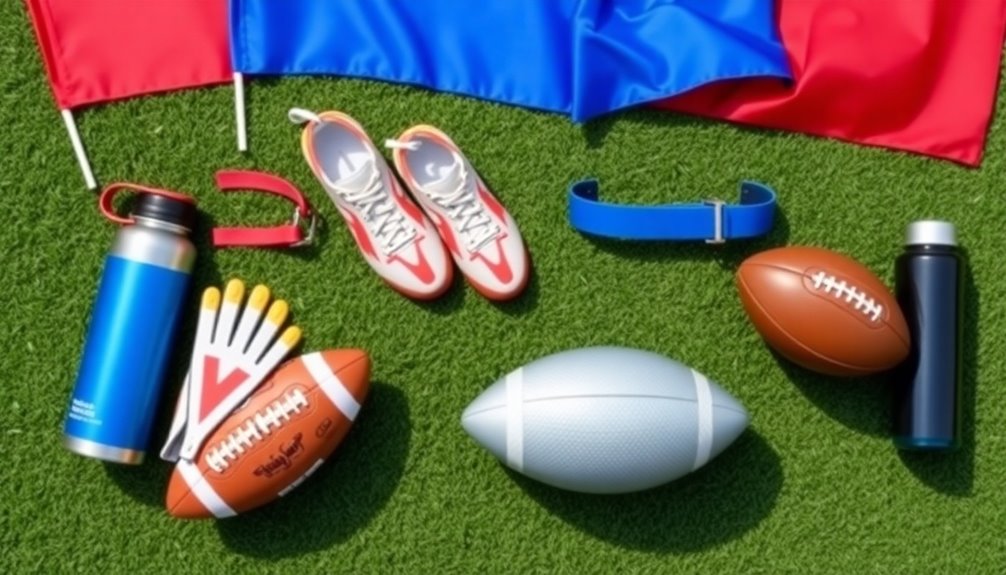
When it comes to optional accessories, football gloves can really enhance your grip and control on the field.
The comfort and fit of these items play an essential role in how well you perform, so it's worth trying a few different styles.
Enhancing Performance With Gloves
Boosting your game with the right gloves can greatly enhance your performance on the flag football field. Receiver gloves are vital for improving your grip on the football, making it easier to catch passes and maintain control during play. These gloves often feature a tacky surface that considerably enhances ball handling, especially in wet or humid conditions, giving you the edge you need when it matters most.
While wearing gloves isn't mandatory, many players find that they provide extra comfort and support, allowing for better focus on the game. Additionally, gloves can offer protection against minor injuries, such as abrasions or impacts, which may occur while catching or defending against passes. This added layer of safety can help you play more confidently without worrying about hand injuries.
When choosing gloves, it's important to select a pair that fits well and complies with your league's regulations to guarantee peak performance. Investing in quality receiver gloves can elevate your game, keeping you ready for any challenge on the field.
Comfort and Fit Importance
Finding the right comfort and fit in optional accessories can greatly impact your performance on the flag football field. When you're wearing well-fitted gloves, you'll notice a significant improvement in your grip on the ball, enhancing your control during gameplay. This simple addition can make all the difference during those vital moments on the field.
Properly fitting cleats are essential for providing traction, which helps prevent slips and falls as you maneuver quickly. When your footwear fits correctly, you can focus more on the game rather than worrying about your footing.
Compression apparel is another key accessory that aids in muscle support and recovery. It can help you maintain mobility throughout the game and reduce fatigue, allowing you to play at your best for longer.
Additionally, opting for pocketless shorts not only complies with safety regulations but also enhances the visibility of your flags, minimizing the risk of injuries during pulls.
League Variations
Flag football leagues can differ greatly in their requirements and rules, leading to a variety of gear specifications that players must navigate. When you join a league, it's essential to understand the specific rules that govern your flag football team. For instance, some leagues may allow soft shell helmets, while others might not, affecting your equipment requirements.
You'll also need to pay attention to the number of players allowed on the field. A 7-on-7 format could require unique gear that you wouldn't need in a standard 5-on-5 setup. In addition, different leagues may enforce guidelines on the types of cleats permitted, often limiting players to molded cleats to reduce injury risks.
The structure of your league can also impact gameplay, including game duration, scoring systems, and timeout allowances.
Warm-Up Drills
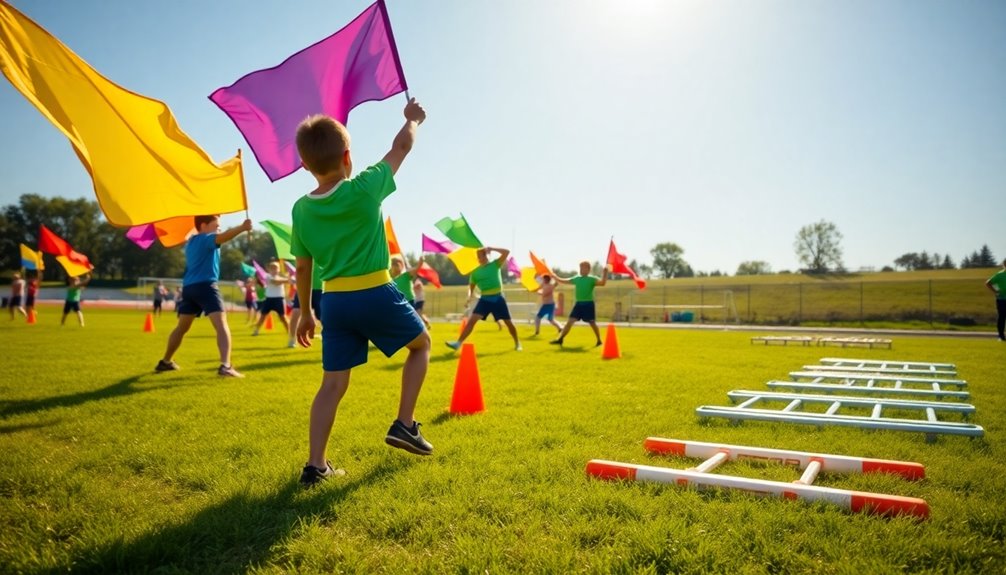
Effective warm-up drills are essential for preparing your body for the demands of flag football. A good start is a Dynamic Warm-Up, which includes a series of dynamic stretches and movements designed to activate your muscles and prevent injuries.
Begin with high knees, running in place while lifting your knees high to build lower body strength and improve your overall speed.
Next, incorporate the Shuffle Drill, focusing on side-to-side movements that enhance your lateral agility. This drill is important for evading defenders during gameplay.
Following that, you can practice the Back Pedal Drill, which helps you develop backward running skills, critical for defensive positioning.
Don't forget the Karaoke Drill, a sideways grapevine run that boosts your coordination and speed. This drill is perfect for helping you change directions quickly on the field, giving you an edge over opponents.
Conditioning Drills
After warming up, it's time to focus on conditioning drills that elevate your performance on the field. One effective drill is the Back Pedal Sprint. This involves back pedaling followed by a quick sprint, enhancing your speed and agility for those essential changes during gameplay.
Another great exercise is the Line Touch Drill, which emphasizes rapid shifts between backward and forward movements. This helps improve your overall footwork and responsiveness.
Incorporating athletic position balance into your drills is vital. By focusing on maintaining stability and control while sprinting, you'll be better prepared for dynamic movements on the field.
Repetition is key; consistently practicing these conditioning drills builds your endurance and refines your skills, ensuring you perform effectively throughout games.
Additionally, keep field awareness in mind as you train. Being aware of your surroundings while executing these drills allows you to adapt your movements based on the game's flow and positioning.
Game Day Preparation
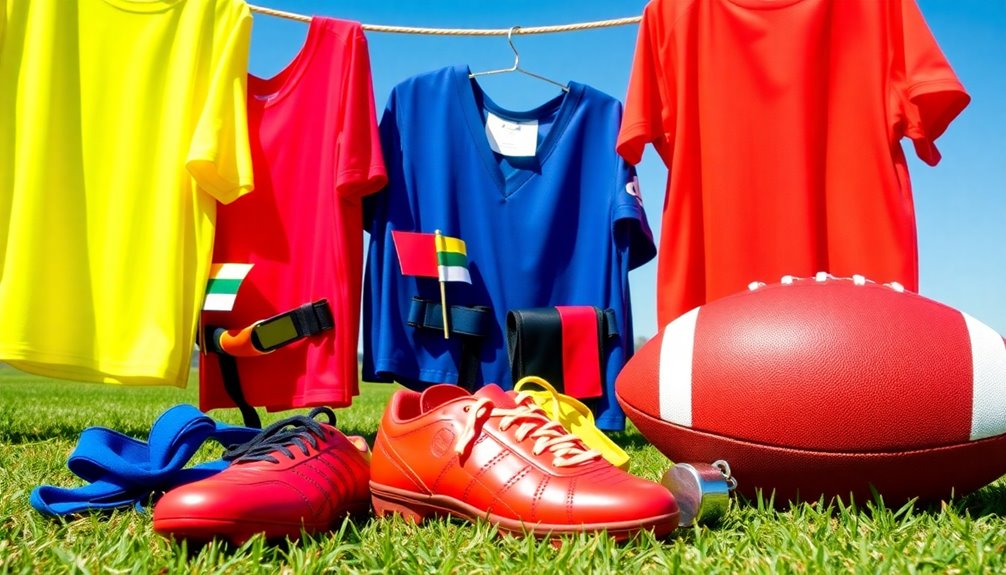
Game day is the culmination of all your hard work and practice, so it's essential to prepare effectively. Start by honing your 2-step handoff technique, guaranteeing precise hand placement between you, the quarterback, and the ball carrier. This practice will set the stage for seamless execution during the game.
As a quarterback, you need to guarantee that the ball carrier aligns closely behind you to facilitate quick and efficient plays. Synchronization of movements is key—focus on snap timing to make those handoffs smooth. Remember, a well-timed snap can make a huge difference in your offensive strategy.
During gameplay, guarantee every player tucks the ball securely. Maintaining possession is fundamental to prevent turnovers and keep the momentum on your side.
Lastly, engage with local leagues to find or register for flag football games. This connection not only enhances your game day experience but also builds camaraderie among players.
With the right preparation, you'll be ready to take the field and showcase your skills. Now, go out there and make the most of your game day!
Field and Team Specifications
When you step onto the field, you'll notice that flag football is designed for fast-paced action, with a typical team featuring just five players on the field at once. The standard field dimensions range from 25 to 30 yards in width and 70 yards in length, providing a compact area that enhances the intensity of the game.
Each flag football field includes two 10-yard end zones, creating ample scoring opportunities for your offensive plays.
As you strategize with your flag football team, pay attention to the midfield line, which serves as a critical marker for play. You'll also need to navigate two no-run zones, enforced 5 yards before both the midfield and end zones, which adds an extra layer of challenge.
This compact design not only speeds up gameplay but also encourages you to develop strategic plays and effective teamwork.
With a smaller field, you'll need to think quickly and adapt your game plans on the fly. So, whether you're on offense or defense, being aware of the field dimensions and how they impact your strategy will help you excel in this exciting sport.
Player Positions and Responsibilities
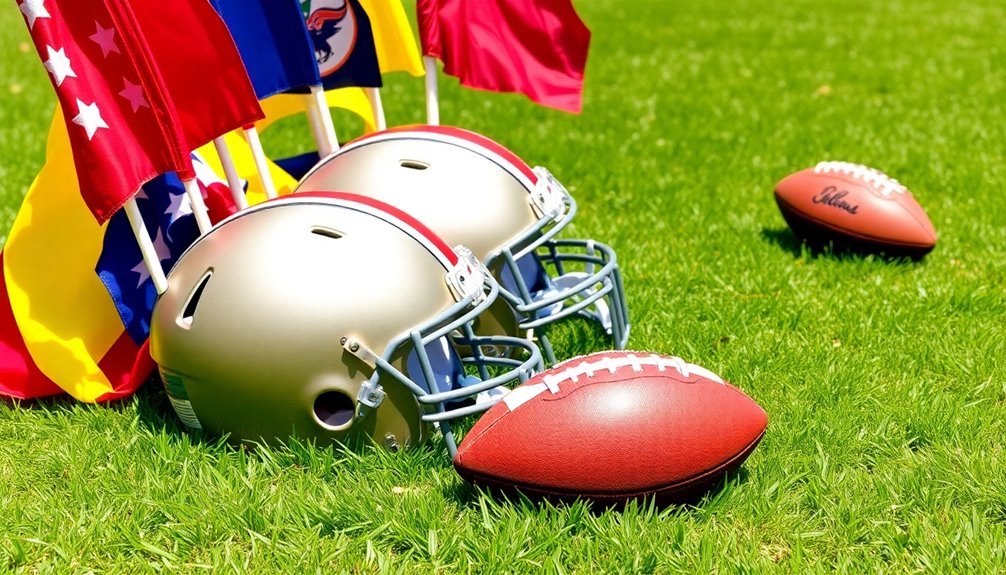
In flag football, each player typically has a specific role that's fundamental to the team's success. The center snaps the ball to the quarterback, and they can also catch passes if eligible.
The quarterback, after receiving the snap, directs the offense and focuses solely on passing the ball—running after the snap isn't allowed.
Wide receivers and running backs are significant players, eligible to receive handoffs and passes to advance the ball down the field. Their speed and agility help create opportunities for successful plays.
Meanwhile, the rusher's job is to apply pressure on the quarterback. They must remain at least 7 yards back before the snap to avoid penalties, but once the play starts, they'll do everything they can to disrupt the quarterback's rhythm.
On the defensive side, defensive backs play an important role. They cover the wide receivers and aim to prevent successful passes or runs, ensuring the defense remains strong.
Conclusion
As you lace up your cleats and don your gear, remember that flag football is more than just a game; it's a dance of strategy and teamwork. With the right equipment, proper conditioning, and a spirited mindset, you're ready to embrace the thrill of the field. So, step onto that grass with confidence, and let your competitive spirit soar like an eagle, weaving through challenges and creating unforgettable moments with your teammates. Enjoy the journey!


